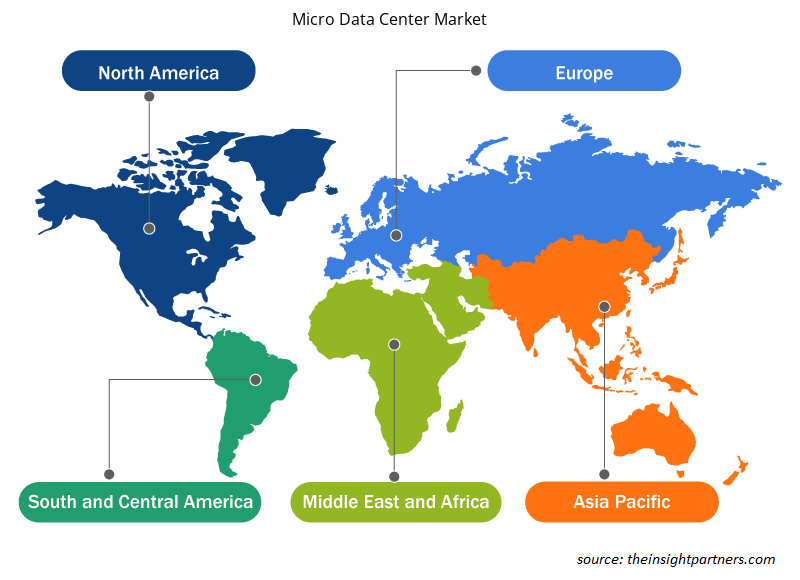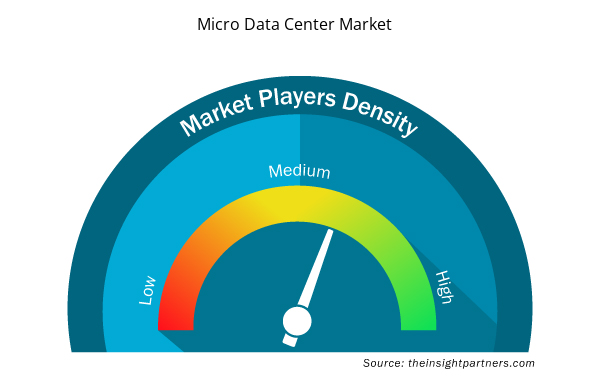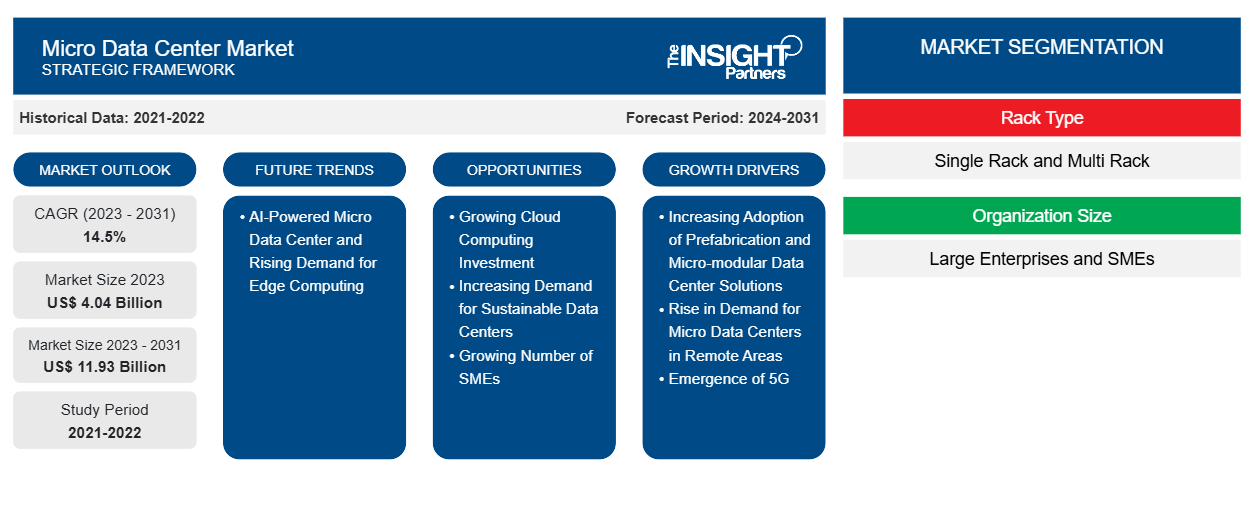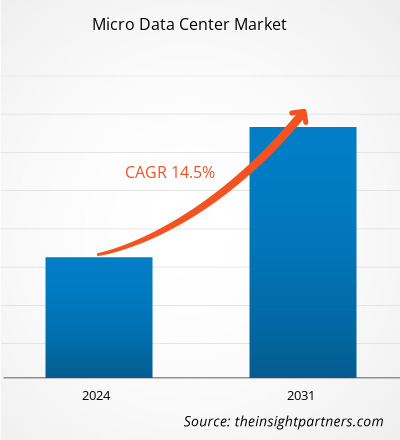من المتوقع أن يصل حجم سوق مراكز البيانات الصغيرة إلى 11.93 مليار دولار أمريكي بحلول عام 2031 من 4.04 مليار دولار أمريكي في عام 2023. ومن المتوقع أن يسجل السوق معدل نمو سنوي مركب بنسبة 14.5٪ من عام 2023 إلى عام 2031. ومن المرجح أن تكون مراكز البيانات الصغيرة المدعومة بالذكاء الاصطناعي وارتفاع الطلب على الحوسبة الحافة من الاتجاهات الرئيسية للسوق.
تحليل سوق مراكز البيانات الصغيرة
أدى الاستخدام المتزايد للأجهزة المتصلة وأجهزة إنترنت الأشياء والطرح المتزايد لشبكة الجيل الخامس إلى زيادة الطلب على معالجة البيانات وتخزينها ذات زمن الوصول المنخفض في كل مكان، بما في ذلك المواقع النائية. وقد أدى هذا إلى زيادة الحاجة إلى المزيد من مراكز البيانات الصغيرة، وخاصة في المواقع النائية، وهو أحد العوامل الرئيسية التي تغذي نمو سوق مراكز البيانات الصغيرة . بالإضافة إلى ذلك، يمكن لمراكز البيانات الصغيرة، بحجمها الصغير، أن تساعد في خفض الطاقة اللازمة للتبريد، كما يساعد وضعها بالقرب من مصادر البيانات في تقليل الطاقة المفقودة أثناء نقل البيانات لمسافات طويلة. يمكن أن يساعد هذا الشركات على تحقيق هدف الاستدامة، مما يخلق فرصة لنمو السوق. تشهد مناطق مثل أمريكا الشمالية وأوروبا والشرق الأوسط وأفريقيا ارتفاعًا في عدد الشركات الصغيرة والمتوسطة الحجم، ومن المتوقع أن يدفع ذلك نمو سوق مراكز البيانات الصغيرة خلال فترة التنبؤ. علاوة على ذلك، يتزايد الطلب على تقنية الحوسبة الحافة لأنها يمكن أن تساعد في معالجة البيانات وتحليلها في الوقت الفعلي، مما يزيد من نمو السوق.
نظرة عامة على سوق مراكز البيانات الصغيرة
مركز البيانات الصغير هو مركز بيانات صغير الحجم يتألف من جميع البنية الأساسية للحوسبة والتخزين والشبكات والطاقة والتبريد وغيرها من البنية الأساسية المطلوبة لحمل عمل معين. تشتمل غالبية مراكز البيانات الصغيرة على رفوف الخوادم ومعدات الشبكة والخوادم وحلول التبريد داخل الرفوف. عادةً، تدعم مراكز البيانات الصغيرة أحمالًا حرجة لا تزيد عن 100-150 كيلو وات وتأتي بأحجام تتراوح من رف واحد مقاس 19 بوصة إلى حاوية شحن بطول 40 قدمًا. نظرًا لحجمها الصغير، يمكن تركيبها في مساحات لا يكون فيها مركز البيانات القياسي ممكنًا. إنها مثالية للتطبيقات الهامشية، وخاصة في المواقع الموزعة أو النائية أو غير المكيفة. نظرًا لأن النظام بأكمله محاط بحجم رف تكنولوجيا المعلومات القياسي، يمكن نشر مراكز البيانات الصغيرة في خزائن الشبكة الحالية أو غرف الخوادم الصغيرة أو مساحات المكاتب المفتوحة أو متاجر التجزئة والعيادات.
قم بتخصيص هذا التقرير ليناسب متطلباتك
ستحصل على تخصيص لأي تقرير - مجانًا - بما في ذلك أجزاء من هذا التقرير، أو تحليل على مستوى الدولة، وحزمة بيانات Excel، بالإضافة إلى الاستفادة من العروض والخصومات الرائعة للشركات الناشئة والجامعات
- احصل على أهم اتجاهات السوق الرئيسية لهذا التقرير.ستتضمن هذه العينة المجانية تحليلاً للبيانات، بدءًا من اتجاهات السوق وحتى التقديرات والتوقعات.
محركات وفرص سوق مراكز البيانات الصغيرة
زيادة اعتماد حلول مراكز البيانات الجاهزة والمصغرة
إن التبني المتزايد لحلول مراكز البيانات الجاهزة والمصغرة الحجم يدفع بشكل كبير نمو سوق مراكز البيانات الصغيرة. ومع سعي المؤسسات إلى تعزيز كفاءتها التشغيلية وقابليتها للتوسع، تقدم هذه الحلول المبتكرة بديلاً مقنعًا لنماذج مراكز البيانات التقليدية. يسمح التصميم المعياري بالنشر السريع والمرونة، مما يمكن الشركات من الاستجابة بسرعة للطلبات المتغيرة وتحسين بنيتها التحتية. وهذا مهم بشكل خاص في قطاعات مثل تكنولوجيا المعلومات والاتصالات والرعاية الصحية ، حيث تتزايد الحاجة إلى قدرات معالجة البيانات المتقدمة. يعزز التصميم المعياري لمراكز البيانات الصغيرة جاذبيتها بشكل كبير عبر مختلف الصناعات من خلال تمكين النشر المرن وفي الوقت المناسب المصمم لتلبية الاحتياجات الفريدة لكل قطاع. تعني هذه القدرة على التكيف أن المؤسسات يمكنها توسيع بنيتها التحتية بسرعة استجابة للطلبات المتقلبة، مما يسمح لها بإدارة الموارد بكفاءة دون فترات زمنية طويلة مرتبطة عادةً ببناء مراكز البيانات التقليدية. على سبيل المثال، في صناعة تكنولوجيا المعلومات، يمكن للشركات نشر مراكز بيانات صغيرة لدعم الخدمات السحابية والحوسبة الحافة، مما يضمن الحد الأدنى من زمن الوصول وتحسين الأداء للمستخدمين النهائيين. وعلى نحو مماثل، تستفيد صناعة الاتصالات من القدرة على تركيب وحدات معيارية بسرعة في مواقع استراتيجية، مما يعزز موثوقية الشبكة وسعتها، وخاصة مع طرح تقنية الجيل الخامس. وفي قطاع الخدمات المصرفية، حيث تعد أمن البيانات والامتثال أمرًا بالغ الأهمية، يمكن تنفيذ مراكز البيانات المعيارية الدقيقة بسرعة لحماية المعلومات الحساسة مع توفير القوة الحسابية اللازمة للمعاملات والتحليلات. ومع ارتفاع معدلات النمو في سعة مراكز البيانات في هذه الصناعات، فإن وحدات مراكز البيانات الدقيقة تجعلها الحل الأمثل لدعم احتياجات البنية التحتية المتطورة بكفاءة وفعالية.
الاستثمارات المتزايدة في الحوسبة السحابية
ومن المتوقع أن يعزز الاستثمار المتزايد في الحوسبة السحابية سوق مراكز البيانات الصغيرة بشكل كبير، مدفوعًا بالطلب المتزايد على حلول معالجة البيانات الفعّالة والقابلة للتطوير والمرنة. على سبيل المثال، أعلنت شركة أوراكل في يونيو 2024 عن نيتها استثمار أكثر من مليار دولار أمريكي لإنشاء منطقة سحابية ثالثة في مدريد، بهدف تعزيز تطوير مهارات الذكاء الاصطناعي في جميع أنحاء البلاد. وستعمل منطقة السحابة العامة الجديدة هذه على تمكين عملاء وشركاء أوراكل عبر مختلف الصناعات في إسبانيا، بما في ذلك قطاع الخدمات المالية المهم، من تحويل أحمال العمل المهمة من مراكز البيانات المحلية إلى البنية التحتية السحابية لشركة أوراكل (OCI). بالإضافة إلى ذلك، ستدعم هذه المبادرة المؤسسات في تلبية المتطلبات التنظيمية الأساسية، مثل قانون المرونة التشغيلية الرقمية (DORA) والمبادئ التوجيهية الأوروبية للاستعانة بمصادر خارجية التي وضعتها EBA وEIOPA وESMA. وقد تم تعيين شركة Telefónica España كشريك مضيف لمنطقة السحابة القادمة، مما يعزز الجهود التعاونية لتطوير قدرات السحابة في المنطقة. مع استمرار الشركات في تبني تقنيات الحوسبة السحابية، ستلعب مراكز البيانات الصغيرة دورًا حاسمًا في تلبية احتياجات البنية التحتية المتطورة لديها، مما يؤدي في نهاية المطاف إلى تشكيل مستقبل إدارة البيانات عبر مختلف القطاعات.
تقرير تحليل تجزئة سوق مراكز البيانات الصغيرة
إن القطاعات الرئيسية التي ساهمت في اشتقاق تحليل سوق مراكز البيانات الصغيرة هي نوع الرف، وحجم المنظمة، والتطبيق.
- بناءً على نوع الرف، يتم تقسيم السوق إلى رف واحد ورفوف متعددة. سيطر قطاع الرف الواحد على السوق في عام 2023.
- من حيث حجم المنظمة، يتم تصنيف السوق إلى الشركات الكبيرة والشركات الصغيرة والمتوسطة. سيطر قطاع الشركات الكبيرة على السوق في عام 2023.
- بناءً على التطبيق، ينقسم السوق إلى BFSI، وتجارة التجزئة، وتكنولوجيا المعلومات والاتصالات، والتصنيع، والرعاية الصحية، وغيرها. هيمن قطاع تكنولوجيا المعلومات والاتصالات على السوق في عام 2023.
تحليل حصة سوق مراكز البيانات الصغيرة حسب المنطقة الجغرافية
- تم تقسيم سوق مراكز البيانات الصغيرة إلى خمس مناطق رئيسية: أمريكا الشمالية وأوروبا وآسيا والمحيط الهادئ (APAC) والشرق الأوسط وأفريقيا (MEA) وأمريكا الجنوبية والوسطى. سيطرت أمريكا الشمالية على السوق في عام 2023، تليها أوروبا ومنطقة آسيا والمحيط الهادئ.
- تنقسم سوق مراكز البيانات الصغيرة في أمريكا الشمالية إلى الولايات المتحدة وكندا والمكسيك. تشهد سوق مراكز البيانات الصغيرة في أمريكا الشمالية نموًا كبيرًا، مدفوعًا بشكل أساسي بالطلب المتزايد على حلول الحوسبة الطرفية ونشر البنية التحتية لشبكة الجيل الخامس. شركات الاتصالات في الولايات المتحدة نشطة بشكل خاص في هذا المجال، حيث تضع مراكز البيانات الصغيرة بشكل استراتيجي في أبراج الخلايا ونقاط تجميع الشبكة لتحسين أداء الشبكة وتقليل زمن الوصول. ومن المتوقع أن يعزز طرح حلول الطاقة المبتكرة، مثل أنظمة إمداد الطاقة غير المنقطعة المتقدمة (UPS)، السوق بشكل أكبر. علاوة على ذلك، فإن التحول الرقمي المستمر عبر مختلف القطاعات، إلى جانب الحجم المتزايد من البيانات التي تولدها أجهزة إنترنت الأشياء، يدفع الطلب على مراكز البيانات الصغيرة. توفر هذه المرافق مزايا مثل قابلية النقل وقابلية التوسع وكفاءة الطاقة، مما يجعلها خيارًا جذابًا للمؤسسات التي تتطلع إلى تعزيز استراتيجيات إدارة البيانات الخاصة بها.
رؤى إقليمية حول سوق مراكز البيانات الصغيرة
لقد قام المحللون في Insight Partners بشرح الاتجاهات والعوامل الإقليمية المؤثرة على سوق مراكز البيانات الصغيرة طوال فترة التوقعات بشكل شامل. يناقش هذا القسم أيضًا قطاعات سوق مراكز البيانات الصغيرة والجغرافيا في جميع أنحاء أمريكا الشمالية وأوروبا ومنطقة آسيا والمحيط الهادئ والشرق الأوسط وأفريقيا وأمريكا الجنوبية والوسطى.

- احصل على البيانات الإقليمية المحددة لسوق مراكز البيانات الصغيرة
نطاق تقرير سوق مراكز البيانات الصغيرة
| سمة التقرير | تفاصيل |
|---|---|
| حجم السوق في عام 2023 | 4.04 مليار دولار أمريكي |
| حجم السوق بحلول عام 2031 | 11.93 مليار دولار أمريكي |
| معدل النمو السنوي المركب العالمي (2023 - 2031) | 14.5% |
| البيانات التاريخية | 2021-2022 |
| فترة التنبؤ | 2024-2031 |
| القطاعات المغطاة | حسب نوع الرف
|
| المناطق والدول المغطاة | أمريكا الشمالية
|
| قادة السوق وملفات تعريف الشركات الرئيسية |
|
كثافة اللاعبين في سوق مراكز البيانات الصغيرة: فهم تأثيرها على ديناميكيات الأعمال
يشهد سوق مراكز البيانات الصغيرة نموًا سريعًا، مدفوعًا بالطلب المتزايد من المستخدم النهائي بسبب عوامل مثل تفضيلات المستهلكين المتطورة والتقدم التكنولوجي والوعي المتزايد بفوائد المنتج. ومع ارتفاع الطلب، تعمل الشركات على توسيع عروضها والابتكار لتلبية احتياجات المستهلكين والاستفادة من الاتجاهات الناشئة، مما يؤدي إلى زيادة نمو السوق.
تشير كثافة اللاعبين في السوق إلى توزيع الشركات أو المؤسسات العاملة في سوق أو صناعة معينة. وهي تشير إلى عدد المنافسين (اللاعبين في السوق) الموجودين في مساحة سوق معينة نسبة إلى حجمها أو قيمتها السوقية الإجمالية.
الشركات الرئيسية العاملة في سوق مراكز البيانات الصغيرة هي:
- شركة إيتون المحدودة
- كانون تكنولوجيز المحدودة
- SCHÄFER Ausstattungssysteme GmbH
- شركة ريتال المحدودة وشركاه
- شركة دلتا للإلكترونيات
- شركة داتويلر لتكنولوجيا المعلومات والبنية التحتية المحدودة
إخلاء المسؤولية : الشركات المذكورة أعلاه ليست مرتبة بأي ترتيب معين.

- احصل على نظرة عامة على أهم اللاعبين الرئيسيين في سوق مراكز البيانات الصغيرة
أخبار سوق مراكز البيانات الصغيرة والتطورات الأخيرة
يتم تقييم سوق مراكز البيانات الصغيرة من خلال جمع البيانات النوعية والكمية بعد البحث الأولي والثانوي، والذي يتضمن منشورات الشركات المهمة وبيانات الجمعيات وقواعد البيانات. فيما يلي بعض التطورات في سوق مراكز البيانات الصغيرة:
- قدمت شركة Vertiv، المزود العالمي للبنية التحتية الرقمية الحرجة وحلول الاستمرارية، نظام Vertiv SmartAisle 3، وهو نظام مركز بيانات صغير الحجم يستخدم قوة الذكاء الاصطناعي، مما يوفر ذكاءً معززًا ويمكِّن من العمليات الفعّالة داخل بيئة مركز البيانات. يتوفر SmartAisle 3 الآن في جنوب شرق آسيا وأستراليا ونيوزيلندا، ويمكن تكوينه حتى 120 كيلو وات من إجمالي حمولة تكنولوجيا المعلومات. إنه مثالي لمجموعة واسعة من تطبيقات الصناعة، بما في ذلك الخدمات المصرفية والرعاية الصحية والحكومة والنقل.
(المصدر: Vertiv، بيان صحفي، أبريل 2024)
- أطلقت شركة Rittal GmbH & Co. KG منتجًا جديدًا، وهو مراكز البيانات الصغيرة RiMatrix. تعد مراكز البيانات الصغيرة RiMatrix موطنًا مدمجًا وقويًا ومتكاملًا لأجهزة تكنولوجيا المعلومات. تضمن مراكز البيانات الصغيرة RiMatrix من Rittal أن تكنولوجيا المعلومات معبأة بشكل آمن وتعمل بأقل انبعاثات كربونية، بغض النظر عن الموقع. وعلاوة على ذلك، فإن الجمع بين التوحيد القياسي العالمي والقدرة على التكيف يعني أن هذه الحزم الجديدة تستفيد بشكل أفضل من مزاياها.
(المصدر: Rittal GmbH & Co. KG، بيان صحفي، نوفمبر 2022)
تقرير سوق مراكز البيانات الصغيرة يغطي المنتجات المطلوبة
يوفر "حجم سوق مراكز البيانات الصغيرة والتوقعات (2021-2031)" تحليلاً مفصلاً للسوق يغطي المجالات المذكورة أدناه:
- حجم سوق مراكز البيانات الصغيرة وتوقعاتها على المستويات العالمية والإقليمية والوطنية لجميع قطاعات السوق الرئيسية التي يغطيها النطاق
- اتجاهات سوق مراكز البيانات الصغيرة، بالإضافة إلى ديناميكيات السوق مثل المحركات والقيود والفرص الرئيسية
- تحليل مفصل لـ PEST و SWOT
- تحليل سوق مراكز البيانات الصغيرة يغطي اتجاهات السوق الرئيسية والإطار العالمي والإقليمي والجهات الفاعلة الرئيسية واللوائح والتطورات الأخيرة في السوق
- تحليل المشهد الصناعي والمنافسة الذي يغطي تركيز السوق، وتحليل خريطة الحرارة، واللاعبين البارزين، والتطورات الأخيرة لسوق مراكز البيانات الصغيرة
- ملفات تعريف الشركة التفصيلية
- التحليل التاريخي (سنتان)، السنة الأساسية، التوقعات (7 سنوات) مع معدل النمو السنوي المركب
- تحليل PEST و SWOT
- حجم السوق والقيمة / الحجم - عالميًا وإقليميًا وقطريًا
- الصناعة والمنافسة
- مجموعة بيانات Excel



Report Coverage
Revenue forecast, Company Analysis, Industry landscape, Growth factors, and Trends

Segment Covered
This text is related
to segments covered.

Regional Scope
North America, Europe, Asia Pacific, Middle East & Africa, South & Central America

Country Scope
This text is related
to country scope.
الأسئلة الشائعة
The market is anticipated to expand at a CAGR of 14.5% during 2023-2031.
Schneider Electric, Legrand SA, Eaton, Rittal GmbH & Co. KG, and Delta Electronics Inc are major players in the market.
The market is expected to reach a value of US$ 11.9 billion by 2031.
North America is anticipated to dominate the micro data center market in 2023.
Rise in demand for micro data centers in remote areas, increasing adoption of prefabrication and micro-modular data center solutions and emergence of 5G are driving the market growth.
AI-powered micro data center and rising demand for edge computing is a key trend in the market.
The List of Companies - Micro Data Center Market
- Eaton Corp Plc
- Cannon Technologies Ltd
- SCHÄFER Ausstattungssysteme GmbH
- Rittal GmbH & Co KG
- Delta Electronics Inc
- Datwyler IT Infra GmbH
- Schneider Electric SE
- Intellinet Network Solutions
- Panduit
- Legrand SA
The Insight Partners performs research in 4 major stages: Data Collection & Secondary Research, Primary Research, Data Analysis and Data Triangulation & Final Review.
- Data Collection and Secondary Research:
As a market research and consulting firm operating from a decade, we have published and advised several client across the globe. First step for any study will start with an assessment of currently available data and insights from existing reports. Further, historical and current market information is collected from Investor Presentations, Annual Reports, SEC Filings, etc., and other information related to company’s performance and market positioning are gathered from Paid Databases (Factiva, Hoovers, and Reuters) and various other publications available in public domain.
Several associations trade associates, technical forums, institutes, societies and organization are accessed to gain technical as well as market related insights through their publications such as research papers, blogs and press releases related to the studies are referred to get cues about the market. Further, white papers, journals, magazines, and other news articles published in last 3 years are scrutinized and analyzed to understand the current market trends.
- Primary Research:
The primarily interview analysis comprise of data obtained from industry participants interview and answers to survey questions gathered by in-house primary team.
For primary research, interviews are conducted with industry experts/CEOs/Marketing Managers/VPs/Subject Matter Experts from both demand and supply side to get a 360-degree view of the market. The primary team conducts several interviews based on the complexity of the markets to understand the various market trends and dynamics which makes research more credible and precise.
A typical research interview fulfils the following functions:
- Provides first-hand information on the market size, market trends, growth trends, competitive landscape, and outlook
- Validates and strengthens in-house secondary research findings
- Develops the analysis team’s expertise and market understanding
Primary research involves email interactions and telephone interviews for each market, category, segment, and sub-segment across geographies. The participants who typically take part in such a process include, but are not limited to:
- Industry participants: VPs, business development managers, market intelligence managers and national sales managers
- Outside experts: Valuation experts, research analysts and key opinion leaders specializing in the electronics and semiconductor industry.
Below is the breakup of our primary respondents by company, designation, and region:

Once we receive the confirmation from primary research sources or primary respondents, we finalize the base year market estimation and forecast the data as per the macroeconomic and microeconomic factors assessed during data collection.
- Data Analysis:
Once data is validated through both secondary as well as primary respondents, we finalize the market estimations by hypothesis formulation and factor analysis at regional and country level.
- Macro-Economic Factor Analysis:
We analyse macroeconomic indicators such the gross domestic product (GDP), increase in the demand for goods and services across industries, technological advancement, regional economic growth, governmental policies, the influence of COVID-19, PEST analysis, and other aspects. This analysis aids in setting benchmarks for various nations/regions and approximating market splits. Additionally, the general trend of the aforementioned components aid in determining the market's development possibilities.
- Country Level Data:
Various factors that are especially aligned to the country are taken into account to determine the market size for a certain area and country, including the presence of vendors, such as headquarters and offices, the country's GDP, demand patterns, and industry growth. To comprehend the market dynamics for the nation, a number of growth variables, inhibitors, application areas, and current market trends are researched. The aforementioned elements aid in determining the country's overall market's growth potential.
- Company Profile:
The “Table of Contents” is formulated by listing and analyzing more than 25 - 30 companies operating in the market ecosystem across geographies. However, we profile only 10 companies as a standard practice in our syndicate reports. These 10 companies comprise leading, emerging, and regional players. Nonetheless, our analysis is not restricted to the 10 listed companies, we also analyze other companies present in the market to develop a holistic view and understand the prevailing trends. The “Company Profiles” section in the report covers key facts, business description, products & services, financial information, SWOT analysis, and key developments. The financial information presented is extracted from the annual reports and official documents of the publicly listed companies. Upon collecting the information for the sections of respective companies, we verify them via various primary sources and then compile the data in respective company profiles. The company level information helps us in deriving the base number as well as in forecasting the market size.
- Developing Base Number:
Aggregation of sales statistics (2020-2022) and macro-economic factor, and other secondary and primary research insights are utilized to arrive at base number and related market shares for 2022. The data gaps are identified in this step and relevant market data is analyzed, collected from paid primary interviews or databases. On finalizing the base year market size, forecasts are developed on the basis of macro-economic, industry and market growth factors and company level analysis.
- Data Triangulation and Final Review:
The market findings and base year market size calculations are validated from supply as well as demand side. Demand side validations are based on macro-economic factor analysis and benchmarks for respective regions and countries. In case of supply side validations, revenues of major companies are estimated (in case not available) based on industry benchmark, approximate number of employees, product portfolio, and primary interviews revenues are gathered. Further revenue from target product/service segment is assessed to avoid overshooting of market statistics. In case of heavy deviations between supply and demand side values, all thes steps are repeated to achieve synchronization.
We follow an iterative model, wherein we share our research findings with Subject Matter Experts (SME’s) and Key Opinion Leaders (KOLs) until consensus view of the market is not formulated – this model negates any drastic deviation in the opinions of experts. Only validated and universally acceptable research findings are quoted in our reports.
We have important check points that we use to validate our research findings – which we call – data triangulation, where we validate the information, we generate from secondary sources with primary interviews and then we re-validate with our internal data bases and Subject matter experts. This comprehensive model enables us to deliver high quality, reliable data in shortest possible time.


 احصل على عينة مجانية لهذا التقرير
احصل على عينة مجانية لهذا التقرير